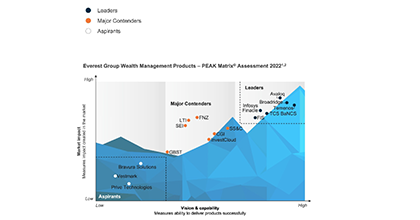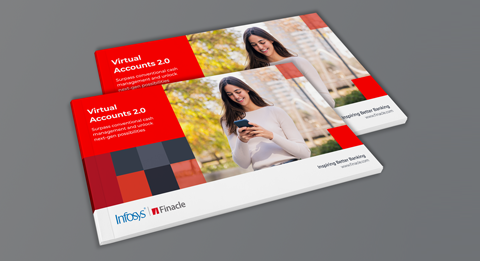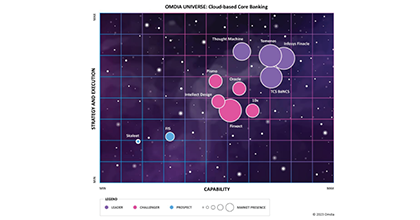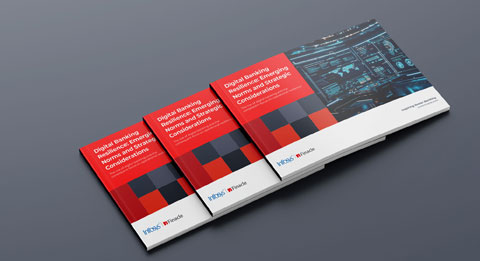-
![]() ESG in bankingESG-conscious banking should create new and future-proof value streams to build a sustainable and resilient business.Read More
ESG in bankingESG-conscious banking should create new and future-proof value streams to build a sustainable and resilient business.Read More -
![Everest Group PEAK Matri Everest Group PEAK Matri]() Everest Group PEAK MatrixA comprehensive solution delivering a full spectrum of wealth products as great experiences. It also improves the productivity of financial advisors and streamlRead More
Everest Group PEAK MatrixA comprehensive solution delivering a full spectrum of wealth products as great experiences. It also improves the productivity of financial advisors and streamlRead More -
![]() Subsidiary of an American Bank in IndonesiaFind out how a leading American bank adapts to a digitalized trade and supply chain finance operations as a part of its larger transformation by leveraging Finacle Trade Finance Solution Suite.Read More
Subsidiary of an American Bank in IndonesiaFind out how a leading American bank adapts to a digitalized trade and supply chain finance operations as a part of its larger transformation by leveraging Finacle Trade Finance Solution Suite.Read More
-
![]() Recomposing Banking: Leading the Digital ContinuumReport gives you a glimpse of the major areas where recomposing banking will create significant impact and value, Infosys Finacle has put together a report on..Read More
Recomposing Banking: Leading the Digital ContinuumReport gives you a glimpse of the major areas where recomposing banking will create significant impact and value, Infosys Finacle has put together a report on..Read More -
![]() Core Banking on Cloud: Navigating to the Fast LaneTake a deep dive into cloud-based core banking and explore the imperatives, opportunities and challenges, and the hallmarks of a robust solution.Read More
Core Banking on Cloud: Navigating to the Fast LaneTake a deep dive into cloud-based core banking and explore the imperatives, opportunities and challenges, and the hallmarks of a robust solution.Read More -
![]() Embracing Payments ComposabilityA step-by-step guide for maximizing Real Time Payment opportunities by embracing Payments Composability...Read More
Embracing Payments ComposabilityA step-by-step guide for maximizing Real Time Payment opportunities by embracing Payments Composability...Read More
-
![]() Shaping Banking’s Next: Banking Technology Trends for 2025 and BeyondThe banking industry has been balancing disruption and opportunity for several years now, and the pace of change shows no signs of slowing as we move into 2025 and beyond.Read More
Shaping Banking’s Next: Banking Technology Trends for 2025 and BeyondThe banking industry has been balancing disruption and opportunity for several years now, and the pace of change shows no signs of slowing as we move into 2025 and beyond.Read More -
![]() Virtual Accounts 2.0: Surpass Conventional Cash Management and Unlock Next-Gen PossibilitiesVirtual Account Management was a groundbreaking shift in the banking landscape, revolutionising use cases like cash concentration, pooling, centralised treasury management, and in-house banking (POBO, ROBO, COBO)Read More
Virtual Accounts 2.0: Surpass Conventional Cash Management and Unlock Next-Gen PossibilitiesVirtual Account Management was a groundbreaking shift in the banking landscape, revolutionising use cases like cash concentration, pooling, centralised treasury management, and in-house banking (POBO, ROBO, COBO)Read More -
![]() Unlocking Hybrid CloudAs banks push forward with their digital transformation agenda, cloud serves as a pivotal enabler. Each bank, at varying stages of adoption, crafts its unique path, dictated by context, regulations, and risk appetite.Read More
Unlocking Hybrid CloudAs banks push forward with their digital transformation agenda, cloud serves as a pivotal enabler. Each bank, at varying stages of adoption, crafts its unique path, dictated by context, regulations, and risk appetite.Read More
-
![]() Banking on CloudThis report from Infosys Finacle delves into the need for accelerating cloud adoption, highlights the current state of the industry, and puts forth key recommenRead More
Banking on CloudThis report from Infosys Finacle delves into the need for accelerating cloud adoption, highlights the current state of the industry, and puts forth key recommenRead More -
![]() Omdia Universe | Cloud-based Core BankingIn the report, Omdia highlights the following key capabilities of leading cloud-based core banking providers:Read more
Omdia Universe | Cloud-based Core BankingIn the report, Omdia highlights the following key capabilities of leading cloud-based core banking providers:Read more
-
![]() Emirates NBDEmirates NBD consolidates its operations on a single version for scalability, agility, and standardization.Read More
Emirates NBDEmirates NBD consolidates its operations on a single version for scalability, agility, and standardization.Read More -
![]() A Global Top 5 BankDiscover how a global top 5 bank headquartered in the US accelerated payments transformation.Read More
A Global Top 5 BankDiscover how a global top 5 bank headquartered in the US accelerated payments transformation.Read More -
![]() Union Bank of IndiaUnion Bank of India launches Union Virtual Connect (UVConn) by leveraging WhatsApp to provide customers personalized banking services.Read More
Union Bank of IndiaUnion Bank of India launches Union Virtual Connect (UVConn) by leveraging WhatsApp to provide customers personalized banking services.Read More

Functionality Versus Process Versus UI Versus Regulation
Blogs
The core banking solution was designed initially to centralize accounting in banks and enable their customers to transact from any of the branches or channels connected to the central database. Functionality and processes were built into the core banking solution, based on the software’s country of origin. The primary design was based on the knowledge of local banking/domain experts in the product company. Though the solution catered to most banking needs of a particular country or region, in certain markets, it faced fitment challenges both on functionality and process compliance. Variations in the account opening, customer creation or loan approval process in different markets often required subtle or even major changes in the software solution. Customization was required to achieve process automation to meet market requirements.
Some vendors hired local consultants for their knowledge of functionality and processes specific to their market, to better understand and meet requirements; others gathered local requirements as part of the implementation. Multiple versions/releases of the base software helped address the local requirements in different markets.
Banking processes evolved over time as new regulations were implemented by the regulatory authorities. The software was expected to include risk mitigation and anti-money laundering processes to protect the interest of the clients and banks. As clients acquired additional peripheral systems, the need arose for automation and straight through processing through integration and workflow. This posed architectural and technological challenges to vendors.
In parallel, core banking evolved new functionality and products in the area of deposits, lending, trade finance, cash management etc. This required the software to be constantly developed, resulting in new product versions or releases from each vendor. Core banking vendors had to develop new modules and product functionality catering to specific market requirements in order to fight the intense competition and expand into new markets.
Core banking vendors adopted a varied methodology to comply with market specific functionality and processes:
a) Additional layer of market specific functionality over the base product
Some of the solution providers designed a thin layer outside the core database, which could be easily integrated into it to meet country specific regulations and processes. This ensured that the core database remained light and the data elements and functionality remained generic, suited to the global market.
b) Multiple releases catering to different markets
A few solution providers developed the functionality on the base version itself and released market specific versions.
c) Ready to plug in customization infrastructure
Customization infrastructure was utilized to develop the country specific functionality, products and processes. The infrastructure could be used for accommodating new functionality and processes with integration capability.
Each of these methods provided different benefits and challenges. The thin market specific functionality layer option required architectural and structural changes to be effected.
The user interface or front end of the solutions proved inadequate to cater to the next stage of core banking requirements of clients. Most banks/clients preferred a simplified user interface (UI). Easy usability and navigation that required no prior training was the order of the day. Functionality with inbuilt processes and a proper User Interface was considered a unique differentiator of a core banking solution. This required further engineering and customization of the base product screens in line with market needs.
Across the globe, the core banking architecture, which was designed for functionality and accounting required reinvention to meet the increasing complexity of user interface, regulation and process, as well as keep pace with the ever changing business dynamics of functionality in different markets.
Today, core banking vendors should design their products such that the main layer of functionality and accounting remains intact and stable. They need to follow the right strategies to address changes in regulation, process, UI and functionality. Vendors must build a market specific layer of UI, workflow, processes and regulation, which can be easily integrated with the core banking solution and updated regularly through a plug in component. Here, they must take care to employ core architecture, which integrates with external industry standard software for these components, else will find it a challenge to manage customer expectations of functionality, process, user interface and regulation without impacting the solution’s performance, scalability or architecture .



©2025 -Edgeverve Systems Limited | All rights reserved
















